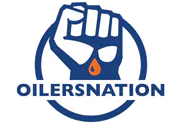In the comment thread a couple of posts down, a few people took issue with Lowetide’s assertion that the Oilers procurement department has done a good job under Kevin Lowe. I’ve previously gone through every draft selection made under Lowe on an individual basis, but I didn’t compare the picks to those made by other teams. This is meant as the first installment in a series where I’ll look at how the Oilers have drafted in comparison to other NHL franchises.
We start with 2001, since Kevin Lowe was promoted to GM in the summer of 2000, too late to have much impact on the draft that season.
The Numbers
Let’s start with some basic statistics, showing the Oilers totals first and NHL average in brackets following:
Total Number of Picks: 11 (9.6)
Draft Position: 13th (of 30)
NHL Games Played by Picks: 547 (500)
NHL Points Scored by Picks: 271 (181)
Round 1
I’ve talked in depth about the Hemsky selection before, and the fact remains that this was a great, and by no means obvious, draft choice. Of players selected in the 2001 Entry Draft, only the 1–2 selections of Ilya Kovalchuk and Jason Spezza have more points than Ales Hemsky, and only Kovalchuk has played more NHL games.
Many pre-draft reports had Hemsky back of players such as Colby Armstrong and Jiri Novotny, both of whom went later in the first round. Hemsky was the best player left in the draft when the Oilers took him, and the pick can’t be considered anything less than a home run.
Rounds 2–3
After a prescient selection in the first round, the Oilers looked much shakier finishing off the top-100 picks, as none of Doug Lynch (43rd), Ed Caron (52nd) or Kenny Smith (84th) ever evolved into NHL players. Mike Cammalleri and Jason Pominville were both available at #42, and Pominville, Peter Budaj and Tomas Plekanec lasted past #52.
I’m very much inclined to give the Oilers a pass on the selection of Doug Lynch. Three years out (2003–04), Lynch scored 36 points in 74 games and played smart physical hockey at the AHL level, even earning two NHL games at the age of 20. In the summer of 2004, Lynch underwent wrist surgery that drastically altered his career (he went from 11 goals in 2003–04 to 1 in 2004–05 in the AHL in the same number of games). He was dealt to St Louis as part of the Chris Pronger trade, suffered a knee injury, and is presently playing for a team in Vienna. Despite appearances, this was a good selection, which was only marred by injury.
On Ed Caron, however, I don’t have much sympathy for the Oilers. He made some poor decisions in college (transferring to Yale, than back to New Hampshire) that cost him a season for no good reason whatsoever, and he managed only 54 games (in the ECHL) as a professional before retiring. It wasn’t a talent problem, but investing a mid-second round pick in a deep draft on a player with off-ice issues is rarely a good idea. Kenny Smith was picked right before a cluster of NHL players over the next 15 picks (Aaron Johnson, Stephane Veilleux, Patrick Sharp, Jordin Tootoo and Ray Emery) and to the best of my knowledge Smith didn’t suffer much in the way of injury.
The Rest of the Way
Edmonton didn’t pick again until the fifth round, and the rest of the way they took shots at either overage Europeans (Jussi Markkanen, Kari Haakana, Ales Pisa) or big-bodied players with significant holes in their game (Jake Brenk, Mikael Svensk, Dan Baum, Shay Stephenson). Obviously, at this stage in the draft, there are more hits than misses, as teams on average got less than 155 games out of their draft picks past this point. Edmonton did well, selecting players with 196 total games.
Jussi Markkanen is clearly the best of the group, a player who was a reliable enough backup to get a shot at a starting job, although most of his success came pre-lockout. Ales Pisa and Kari Haakana both had brief cups of coffee in the NHL, although both still play at a high level in Europe. Of the Coke Machines (to borrow from Lowetide), only Shay Stephenson ever played at the NHL level, playing in two contests for a brutal Los Angeles team in 2006–07.
In Conclusion
The Oilers draft was, on the whole, good compared to the rest of the league. They made two poor picks in the top-100 and had a third player’s career derailed by injury, but the selection of an elite talent in Ales Hemsky at 13th overall covers a lot of sins. In the later rounds, they did well in acquiring some overage European players who could help immediately, but none of their younger long-shots paid off. All in all, it was a very good start for Lowe and Prendergast.
—Jonathan Willis is the force behind Copper and Blue, and a frequent OilersNation contributor.
